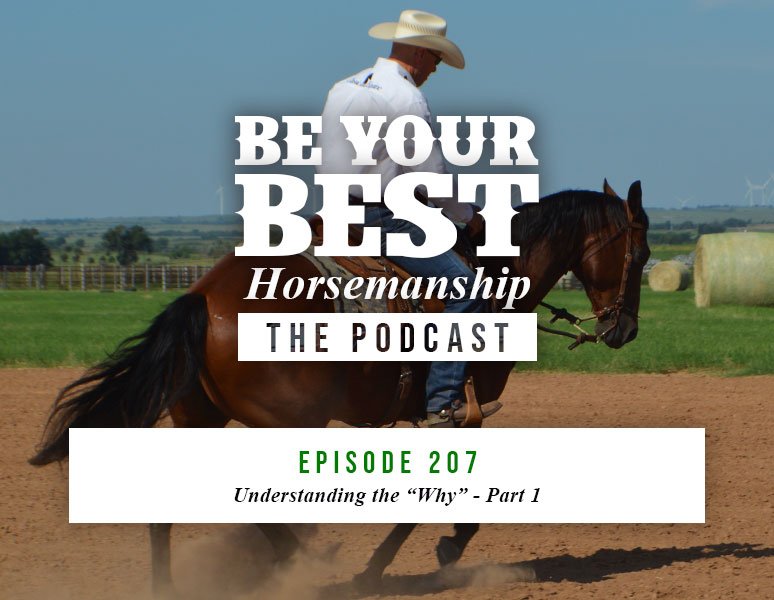Ep 207: Understanding the “Why” - Part 1
On this episode, I’m taking you behind the scenes to introduce you to the topics I cover during the first morning meeting at my clinics. During these meetings, I go over the itinerary for the clinic and introduce my philosophies so that trainers can not only understand what we are about to work on but also why we are working on those things.
Why the “Why” Is Important
Humans are a lot like horses in the sense that they are much more willing to learn and retain information if they understand the why behind their actions. Things make more sense and the puzzle pieces come together much quicker when you understand the purpose behind what you are doing.
The Definition of Horsemanship
Horsemanship is simply communication and leadership. And when I say communication and leadership, I mean the level of communication I have between my mind, my body and the horse’s mind and how I exhibit leadership through the signals I send to that horse’s mind. The only muscle you are communicating with is the horse’s brain. My hands and legs aren’t going to do anything that my mind doesn’t tell them to do, and horses are exactly the same way. The horse’s brain controls every movement they make.
Training Through Understanding
My philosophy is that we don’t train horses physically–we train them mentally. Excellent horsemanship, in my opinion, is the difference between mechanical manipulation and mental understanding. It’s like if I were to shove you around a room… I can move you forward, backward, side-to-side, but you probably won’t understand why I’m doing it. Now, if I told you to go across the room for a specific reason, you would move on your own and go to the destination I intended you to go to. Horses operate the same way. They have to be able to understand the responses we are asking for and why we are asking for them.
Teaching the Release
My horsemanship program is built upon the idea of teaching the release. Horses can be manipulated through pressure and fear, but they don’t learn anything through these methods. When we train by using the release, horses can conductively reason which movements are correct based upon when the release is provided. It’s all about asking for responses in a way they understand. As trainers, we have to develop our skills to the point where we can be outstandingly precise with the release. The release is essential to developing the horse’s foundation.
Feel, Timing and Balance
Feel, timing and balance are three core pillars of horsemanship. Feel is exactly what it sounds like–feeling your horse’s movements. Feel is a hard concept to explain, but once you get it, you’ll have it forever. The only way to achieve feel is to spend time in the saddle. Repetition creates consistency.
Timing is also exactly what it sounds like. It’s the timing of when you ask for a response and when you provide the release. Precision in your timing is imperative to helping the horse understand what you are asking for.
Balance has to do with not only your horse’s balance, but more importantly, your own. Where is your body position? What side is your weight shifted to? What cues are you sending with the reins? With your legs? Balance requires you to be present and be aware of the signals you are sending to your horse. Balance also has to do with your horse’s balance. How is the horse’s weight distributed? Is the horse front-end loaded? Or, is it balanced on its front and hindquarters? Helping your horse achieve balance is key to enabling quick body movements and achieving consistency as the horse changes speed and direction.
Understanding the Horse’s 5 Main Body Parts
My foundational horsemanship program is designed to help you soften and gain precise control of the horse’s five main body parts: head, neck, shoulders, rib cage, hindquarters. These five body parts must be working together and responding at equal levels. Establishing control of these body parts is essential to your horse’s foundation. If one of these five body parts is disconnected or not responsive to the cues you are asking for, you will have some holes in that horse’s foundation.
Everyone is a Trainer
One of the biggest myths in horsemanship is “I’m not a trainer–I just ride my own horses.” I believe that everyone who deals with horses is a trainer. Let me put it to you this way: Another definition of training is influencing action. If you are interacting with a horse in any capacity, you are influencing that animal to take some action. Every interaction you have with a horse presents an opportunity to either create or reinforce positive or negative actions. Even stepping in the pen to catch your horse can elicit a positive or negative response. You don’t even have to saddle the horse to have an influence on that animal. Your presence and energy alone can influence that horse’s behavior. Having an awareness of just how much influence you have over a horse is one of the most important truths to acknowledge in your horsemanship journey.
It’s Okay to Suck at Something Today
Horsemanship is a continual journey of overcoming challenges. Some horses will present less challenges than others, but every horse you deal with will present some kind of challenge at some point in their training. As trainers, these challenges often come to us as a surprise–but why? Why are we surprised when we have a challenge? Life is full of challenges. Learn to expect the challenges, and you will be one step closer to getting out of your own way. It’s perfectly okay to “suck” at something today. Don’t sweat the progression.
Check out the next episode in this series: Episode 208: Understanding the Why: Part 2.
“Be Your Best Horsemanship” is brought to you by Silver Lining Herbs, Classic Equine, Martin Saddlery, Better Horses Network, Purina, Healthycoat, CINCH, Starbar, and Clarifly. These brands have been part of the Phil Haugen Horsemanship team for many years, and their products continue to play an integral role in the success of our performance horse training program. To support these brands, visit our Sponsors tab.




